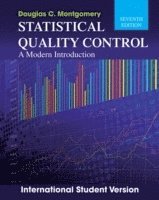
- Format
- Häftad (Paperback / softback)
- Språk
- Engelska
- Antal sidor
- 768
- Utgivningsdatum
- 2012-08-07
- Upplaga
- 7th Edition International Student Version
- Förlag
- John Wiley & Sons Inc
- Illustratör/Fotograf
- Zahlr Abb und Tab
- Illustrationer
- Illustrations
- Dimensioner
- 253 x 203 x 23 mm
- Vikt
- ISBN
- 9781118322574
- 1280 g
Statistical Quality Control
A Modern Introduction
Kundrecensioner
Fler böcker av Douglas C Montgomery
-
Design and Analysis of Experiments, EMEA Edition
Douglas C Montgomery, Douglas C Montgomery
-
Introduction to Time Series Analysis and Forecasting, 1e Student Solutions Manual
Douglas C Montgomery, Cheryl L Jennings, Murat Kulahci, Douglas C Montgomery, Cheryl L Jennings
-
Generalized Linear Models
Raymond H Myers, Douglas C Montgomery, G Geoffrey Vining, Timothy J Robinson, Raymond H Myers
-
Engineering Statistics, SI Version
Douglas C Montgomery, George C Runger, Norma F Hubele, Douglas C Montgomery, George C Runger
Innehållsförteckning
PART 1 INTRODUCTION 1 1 MODERN QUALITY MANAGEMENT AND IMPROVEMENT 3 Chapter Overview and Learning Objectives 3 1.1 The Meaning of Quality and Quality Improvement 4 1.1.1 Dimensions of Quality 4 1.1.2 Quality Engineering Terminology 8 1.2 A Brief History of Quality Control and Improvement 9 1.3 Statistical Methods for Quality Control and Improvement 13 1.4 Management Aspects of Quality Improvement 16 1.4.1 Quality Philosophy and Management Strategies 17 1.4.2 The Link Between Quality and Productivity 35 1.4.3 Supply Chain Quality Management 36 1.4.4 Quality Costs 38 1.4.5 Legal Aspects of Quality 44 1.4.6 Implementing Quality Improvement 45 2 THE DMAIC PROBLEM SOLVING PROCESS 48 Chapter Overview and Learning Objectives 48 2.1 Overview of DMAIC 49 2.2 The Define Step 52 2.3 The Measure Step 54 2.4 The Analyze Step 55 2.5 The Improve Step 56 2.6 The Control Step 57 2.7 Examples of DMAIC 57 2.7.1 Litigation Documents 57 2.7.2 Improving On-Time Delivery 59 2.7.3 Improving Service Quality in a Bank 62 PART 2 STATISTICAL METHODS USEFUL IN QUALITY CONTROL AND IMPROVEMENT 65 3 STATISTICAL MODELS OR QUALITY CONTROL AND IMPROVEMENT 67 Chapter Overview and Learning Objectives 68 3.1 Describing Variation 68 3.1.1 The Stem-and-Leaf Plot 68 3.1.2 The Histogram 70 3.1.3 Numerical Summary of Data 73 3.1.4 The Box Plot 75 3.1.5 Probability Distributions 76 3.2 Important Discrete Distributions 80 3.2.1 The Hypergeometric Distribution 80 3.2.2 The Binomial Distribution 81 3.2.3 The Poisson Distribution 83 3.2.4 The Negative Binomial and Geometric Distributions 86 3.3 Important Continuous Distributions 88 3.3.1 The Normal Distribution 88 3.3.2 The Lognormal Distribution 90 3.3.3 The Exponential Distribution 92 3.3.4 The Gamma Distribution 93 3.3.5 The Weibull Distribution 95 3.4 Probability Plots 97 3.4.1 Normal Probability Plots 97 3.4.2 Other Probability Plots 99 3.5 Some Useful Approximations 100 3.5.1 The Binomial Approximation to the Hypergeometric 100 3.5.2 The Poisson Approximation to the Binomial 100 3.5.3 The Normal Approximation to the Binomial 101 3.5.4 Comments on Approximations 102 4 STATISTICAL INFERENCE IN QUALITY CONTROL AND IMPROVEMENT 108 Chapter Overview and Learning Objectives 109 4.1 Statistics and Sampling Distributions 110 4.1.1 Sampling from a Normal Distribution 111 4.1.2 Sampling from a Bernoulli Distribution 113 4.1.3 Sampling from a Poisson Distribution 114 4.2 Point Estimation of Process Parameters 115 4.3 Statistical Inference for a Single Sample 117 4.3.1 Inference on the Mean of a Population, Variance Known 118 4.3.2 The Use of P-Values for Hypothesis Testing 121 4.3.3 Inference on the Mean of a Normal Distribution, Variance Unknown 122 4.3.4 Inference on the Variance of a Normal Distribution 126 4.3.5 Inference on a Population Proportion 128 4.3.6 The Probability of Type II Error and Sample Size Decisions 130 4.4 Statistical Inference for Two Samples 133 4.4.1 Inference for a Difference in Means, Variances Known 134 4.4.2 Inference for a Difference in Means of Two Normal Distributions, Variances Unknown 136 4.4.3 Inference on the Variances of Two Normal Distributions 143 4.4.4 Inference on Two Population Proportions 145 4.5 What If There Are More Than Two Populations? The Analysis of Variance 146 4.5.1 An Example 146 4.5.2 The Analysis of Variance 148 4.5.3 Checking Assumptions: Residual Analysis 154 4.6 Linear Regression Models 156 4.6.1 Estimation of the Parameters in Linear Regression Models 157 4.6.2 Hypothesis Testing in Multiple Regression 163 4.6.3 Confidance Intervals in Multiple Regression 169 4.6.4 Prediction of New Observations 170 4.6.5 Regression Model Diagnostics 171 PART 3 BASIC METHODS OF STATISTICAL PROCESS CONTROL AND CAPABILITY ANALYSIS 185 5 HOW
Du kanske gillar
-
Nexus
Yuval Noah Harari
Häftad -
Orbital
Samantha Harvey
Häftad
